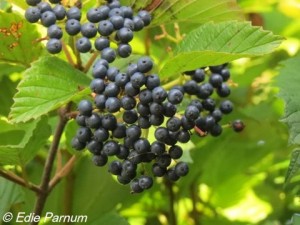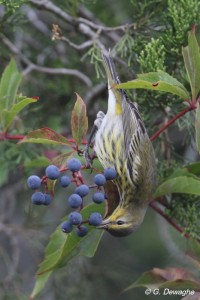By Edie Parnum
Birds were dropping out of the sky into the trees and shrubs around me. It was daybreak on a fall morning in my backyard. Though I could see only silhouettes, I recognized the chips of robins and Swainson’s Thrushes. In the dim light I couldn’t identify the other numerous birds but knew these were migrants that had flown non-stop from the north during the night.
After their nighttime exertion, they were exhausted and ravenously hungry. They needed to find high-energy food and to revive in a habitat offering shelter from predators. With most of the surrounding area covered with buildings, roads, parking
lots, and sterile lawns, they were desperate for sustenance. From above, the migrants probably see the local parks as deceptively inviting, but the grass and other non-native vegetation provide little nutritious food. Their energy depleted, these migrants need familiar and nourishing native plant food. Otherwise they are in trouble.
Watching these migrants, I imagine myself on a road trip, one I’ve done many times. After hours of driving, I’m hungry, tired, and low on gas. I’m looking forward to Rosie’s Restaurant, a favorite stop for good food, gas, and a respite from the journey. To my dismay, the restaurant and adjacent gas station are gone. Wasting time and energy, I must drive around randomly to locate what I need before resuming my trip.
Migrants often find my yard and use it to rest and refuel. During fall migration, especially after a cold front, I search for recent arrivals. Sometimes I find thrushes, tanagers, grosbeaks, and warblers eating berries on the Virginia Creeper, Arrowwood Viburnum, Winterberry Holly, Spicebush, Black Chokeberry, Flowering Dogwood, Crabapple, and Northern Bayberry I’ve planted for them. One winter a southbound Hermit Thrush stayed in my yard all winter eating American Holly berries.
This fall I’ve been watching a Gray Catbird eating berries on the Virginia Creeper
hanging above my deck railing. Because the bird is just a few feet away, I don’t really need my binoculars. It lands on a branch, leans forward, grabs one of the blue-black berries, then quickly swallows—again and again, all day long. Either a resident breeder soon to migrate or a recent arrival using my yard as a stopover, this bird needs these berries. Besides Gray Catbird I’ve seen Red-bellied Woodpecker, Northern Flicker, Brown Thrasher, Cedar Waxwing, Eastern Bluebird, Swainson’s Thrush, American Robin, Cape May Warbler, and Yellow-rumped Warbler eating Virginia Creeper berries.
Prior to migration, songbirds must increase their weight by 50-100%. Thrushes, grosbeaks, waxwings, orioles, tanagers, and other songbirds switch from a diet of insects to mostly berries. Finding berries consumes less energy than pursuing insects. Scott McWilliams and Navindra Seeram, researchers at the University of Rhode Island, are studying the diet of birds preparing for migration on Block Island. According to this new research, birds select deeply-pigmented berries

Highly nutritious Arrowwood Viburnum berries were most preferred by migrants preparing for fall migration in the Block Island study. Photo © Edie Parnum. Click to enlarge.
that are high in antioxidants and fat prior to migration. Antioxidants help birds(as well as humans) handle stress. Because migration is certainly stressful, birds need to find nutrient-rich berries at stopovers along their migratory routes.
Migration is hazardous for birds. On their southward journey they fly at night for four to six hours without a break. They must stop and refuel several times before reaching their wintering grounds, especially if their final destination is the tropics. They spend four to five days at each stopover where most consume nutrient-rich berries. If they fail to find sufficient fuel for the next leg of their journey, they become weak and vulnerable to hawks, owls, and other predators.
Scientists tell us even small patches of native plants can provide food and shelter for migrating birds. On my three quarter acre property, I’ve planted scores of fruit-bearing native shrubs, trees, and vines. Besides the shrubs mentioned, I’ve recently planted Black Gum, Hackberry, Sassafras, and Spicebush that will offer fruits in future autumns. Also, in a few spots I allow Pokeweed (regrettably considered a weed by most gardeners) to grow and produce beautiful dark purple berries irresistible to birds.
Since many ornamental and invasive non-native plants produce berries, why are native plants so important for migrating birds? With their high fat content and extra antioxidants, native berries are highly nutritious. Because the natives usually have

Birds do eat non-native berries. This Gray Catbird is eating invasive Porcelainberry and, regrettably, spreading the seeds. Photo courtesy of and © Adrian Binns/Wildside Nature Tours.com. Click to enlarge.
strongly-colored berries, either black or red, or have leaves or stems that are bright red, birds can easily find them. Also, the native berries ripen at the right time. Many migrants, especially warblers, continue to eat insects as well—found primarily on native plants. If necessary, of course, birds will also eat the less nutritious fruits of non-native plants.
Most yards have room for shrubs. You can plant native fruit-bearing shrubs and small trees around your property’s perimeter to create a hedgerow laden with nutritious fall fruits. You can also group them around isolated trees. By reducing your lawn, you’ll find room for more shrubs and other fruiting plants.
Birds, especially those that migrate to the tropics, are in trouble. On average, the populations of long-distance migrant species drop 1% each year. We assume we can do little except give money to organizations that preserve land. However, we can help migrating birds survive their perilous and crucial journeys by growing the plants they need and love.
References:
http://www.naturalnews.com/029391_birds_superfoods.html#
http://www.sciencedaily.com/releases/2010/03/100324155357.htm
| Top Native Berry Plants for Fall Migrants | |
| Latin Name | Common Name |
| Trees | |
| Celtis occidentalis | Hackberry |
| Cornus florida | Flowering Dogwood |
| Ilex opaca | American Holly |
| Malus coronaria | Crabapple |
| Nyssa sylvatica | Black Gum/ Tupelo |
| Sassafras albidum | Sassafras |
| Shrubs | |
| Aronia arbutifolia, A. melanocarpa | Red Chokeberry, Black Chokeberry |
| Cornus racemosa, C. amonum | Gray Dogwood, Silky Dogwood |
| Ilex verticillata | Winterberry Holly |
| Lindera benzoin | Spicebush |
| Myrica pensylvanica | Bayberry |
| Viburnum acerfolium, V. dentatum, V. lentago,V. nudum, V. prunifolium | Mapleleaf Viburnum, Arrowwood Viburnum, Nannyberry, Possumhaw, Black Haw |
| Vines and Herbaceous Plants | |
| Parthenocissus quinquefolia | Virginia Creeper Vine |
| Phytolacca americana | Pokeweed |





